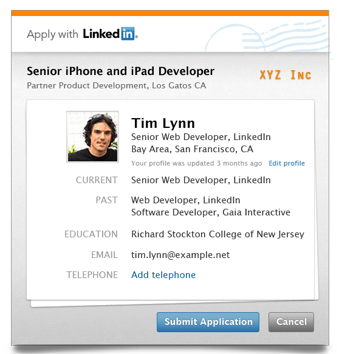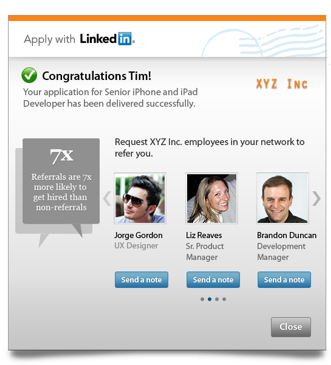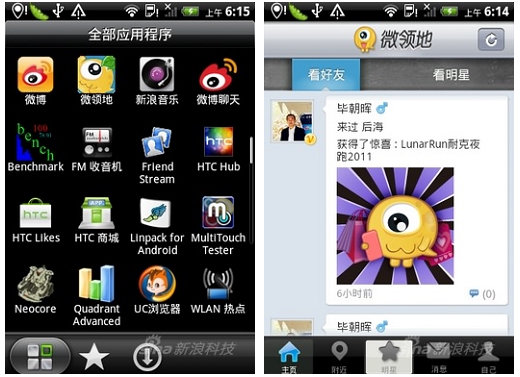The Latest from TechCrunch |  |
- Is M&A Increasing For European Startups? VC Frederic Court Says Yes… And No…
- LinkedIn Debuts Embeddable Job Application Tool For Companies
- Report: Amazon To Use Two-Finger Touchscreen To Keep Table Competitive With The iPad
- All AT&T Android Phones Released In 2011 Will Get Gingerbread
- SamsungDive: Apple’s “Find My iPhone” Just Got A Rival
- IBM On-Screen Keyboard Matches Your Hand Anatomy
- Atomico, Conway, And Founders Fund Put $10 Million Into Quid; Max Levchin Joins Board
- The Astroclip Is An iPhone 4 Clip For Astrophotography
- Intuit Launches QuickBooks Mobile App For Android
- Gossamer Web Browser Runs On Your Graphing Calculator
- Former Microsoft Exec Raises $20 Million For Motif, An Investment Vehicle For Ideas
- One Book Every Entrepreneur and VC Should Own
- The HTC Status/Salsa Facebook Phone Lands In China As The HTC Weike Sina Weibo Phone
- Goshi Debuts Hyperlocal, Mobile Marketplace
- Samsung May Trounce Nokia Once And For All… Is Apple Next?
- Qualcomm Buys Assets From GestureTek To Add Gesture Recognition Technology To Snapdragon
- Holga’s TIM 3D Camera Stares Into Your Soul, Takes 3D Photos Of It
- Breaking: RIM “Streamlining” Operations, Lays Off 2,000
- Mobile App Development Startup Canvas Raises $1.2M From Motorola And Others
- MSI WindPad Enjoy Sneaks Out Thanks To The FCC
| Is M&A Increasing For European Startups? VC Frederic Court Says Yes… And No… Posted: 25 Jul 2011 08:35 AM PDT
|
| LinkedIn Debuts Embeddable Job Application Tool For Companies Posted: 25 Jul 2011 08:30 AM PDT In April, LinkedIn launched new customizable plug-ins, which are features from the professional social network that can be customized and embedded on websites with minimal effort. LinkedIn plug-ins launched with the ability to add Member Profiles, Company Info, and the LinkedIn share button to websites. And today, LinkedIn is rolling out a major plug-in to companies—Apply With LinkedIn. The new plug-in (initial details on the feature were originally revealed by GigaOm in early June), puts an “Apply with LinkedIn” button to any company website. Companies can customize the look and feel of the "Apply with LinkedIn" module to feel like part of a specific branding. And companies can manage submissions by routing applications to email address or a web app for applying for a job. The plug-in can also integrate with Applicant Tracking Systems, and only involves a small snippet of code to embed on a site. Some of the first companies to debut "Apply with LinkedIn" button on their company websites include Netflix, TripIt, and Photobucket. LinkedIn says another thousand companies will be rolling out the Apply With LinkedIn button. From the job applicant’s perspective, you’ll see a description of job and company, and once you click on the "Apply with LinkedIn" button, you’ll be able to preview and update your profile in real time. Once you apply, LinkedIn will also show you your professional connections that work at the company in case you want to reach out to these individuals about the job. You’ll be able to send a note to these connections from the module. If you don't know anybody at the company, LinkedIn will show you connections who can introduce you to someone there (LinkedIn says that on its network, referrals are the top source of external hires at companies). Finally, LinkedIn will record all "Apply with LinkedIn" submissions in the "Saved Jobs" tab so you have a record of all the jobs you've applied to, even off of LinkedIn’s site. Considering how frequently LinkedIn is used for job applications, research and networking, this plugin provides real value for both companies and job seekers. And the ability to add personal data to job applications (i.e. connections who work at a company you are interested in working for) is compelling. LinkedIn’s Share plug-in is seeing impressive results, and traffic is exploding on the network following its IPO in May. The company is ramping up advertising as well, debuting new social ad formats that leverage members' actions on the site to serve more targeted ads. Considering how Facebook is minting money off of social ads, it makes sense for LinkedIn to maximize revenue from this channel. What’s unclear is if the “Apply With LinkedIn” tool will have any financial benefits for the social network. 
|
| Report: Amazon To Use Two-Finger Touchscreen To Keep Table Competitive With The iPad Posted: 25 Jul 2011 08:20 AM PDT Details about the Amazon tablet are slowly emerging as its supposed release draws closer. The latest news out of the Chinese manufacturing scene is that Amazon, like others, are opting for a low-cost touchscreen panel only capable of two-finger multitouch. The iPad and Honeycomb tabs currently use a 10-finger solution. The alternative keeps the cost down while still providing most general functions. Digitimes reports that this practice is becoming more popular for entry-level smartphones and tablets. Amazon, among others, need to compete with Apple on both the functionality and price. Honeycomb already provides most of the former, but expensive components currently limit OEMs and CE companies from offering tablets at more competitive prices. Of course none of this report was confirmed by Amazon. The retailer’s tablet is said to be slated for a fall launch, which also hasn’t been confirmed by the company. The report, if it’s true, shows that Amazon understands the key to competitiveness is price, not straight up cloning. Besides, why does the Amazon tablet need more than two-finger multitouch? It only takes one finger to buy wares from Amazon. |
| All AT&T Android Phones Released In 2011 Will Get Gingerbread Posted: 25 Jul 2011 08:02 AM PDT The HTC Status might be a sort-of-weird, kind-of-gimmicky (with its dedicated Facebook button and all) little piece of kit, but it’s got at least one thing going for it: it’s the only phone on AT&T running on the latest (phone-friendly) version of Android: v2.3, or “Gingerbread”. Not for long, though. AT&T has just confirmed that all of the Android phones they released in 2011 will be getting the Gingerbread upgrade treatment.
The phones AT&T confirmed:
That sure looks like all of AT&T’s 2011 Android line up so far, to me. Anyone spot anything that’s missing? For those of you whose pre-2011 AT&T Android phones didn’t make the cut: keep your fingers crossed. AT&T also confirmed that the non-4G version of the Captivate (which was released in mid-2010) will be gettin’ the bumpgrade — so at the very least, there’s hope. If all else fails, root that thing and get some CyanogenMod-goodness all up inside it. And as for when these updates are coming: ATRIX updates start today, Inspire 4G updates start within two weeks, and, beyond that, your guess is as good as ours. AT&T didn’t give any specific timeframes for the rest — which, to be honest, is probably for the best. Missed launch dates = ragey customers. |
| SamsungDive: Apple’s “Find My iPhone” Just Got A Rival Posted: 25 Jul 2011 08:01 AM PDT Back in the day, the worst part of losing a phone was re-inputting contact information and coughing up the dough for another handset. With today's smartphones, losing your phone is like losing everything. Not only is your very expensive piece of hardware gone, but your banking and credit card info, contacts, passwords, and social networking accounts are all up for grabs out in the world. It's horrifying. Samsung feels our pain, and has thus introduced SamsungDive, which lets you track and remotely control your handset when lost or stolen. GPS provides the user with exact coordinates of the device, and the user can then choose to either lock the device or wipe it clean. The only devices currently supported by SamsungDive are the Galaxy S II, the Galaxy S, the Samsung Wave, and both the Galaxy Tab 8.9 and 10.1 slates. The service is only available in the UK and Germany for now, but should roll out to other countries soon. It's a free service, but it won't do you any good unless you register before your device is lost or stolen. [via Phone Arena] |
| IBM On-Screen Keyboard Matches Your Hand Anatomy Posted: 25 Jul 2011 07:46 AM PDT An IBM patent points to an on-screen keyboard that matches the user’s anatomy, changing to reflect each users “unique typing motion.” The keyboard requires calibration in the form of various exercises. The system then senses various variables like “finger skin touch area, finger size data and finger position.” It then creates a unique keyboard based on a “set of averages.” For example, some of the buttons will be bigger or smaller than others and potentially in different places. This allows for more efficient typing on touchscreens and surface systems. Does this mean IBM is working on a tablet. Nope, but they’re thinking about how to make it easier for folks to work on them. |
| Atomico, Conway, And Founders Fund Put $10 Million Into Quid; Max Levchin Joins Board Posted: 25 Jul 2011 07:45 AM PDT Quantitative analysis startup Quid is getting a major vote of confidence and $10 million in a Series C round from a raft of serious investors. Niklas Zennstrom’s Atomico Ventures, Ron Conway’s SV Angel, Peter Thiel’s Founders Fund, Endeavour Vision, Infocomm Investments, and Korean investor Charles Lho all invested in the Series C financing. (Founders Fund and Lho were already investors. In addition PayPal co-founder Max Levchin has joined the board. In the same predictive analytics space as Recorded Future, the startup previously raised $4M across two rounds, from Founders Fund and angels including Dr Charles Lho, Max Levchin, Gordon Crovitz, Allen Morgan, James Hong, Niko Dounchis — The first round was led by Dr Charles Lho and the second by Founders Fund. You guys might remember Quid from our “Does Quid have the most pretentious website of any startup ever?” post, where we discussed its choice of primary versus secondary typeface and implored the company to get a primary business model before it made a fuss about fonts. Quid CEO Bob Goodson tells me that that pretty snarky post was actually a boon for Quid, and attracted ultra high quality engineers including a “computational linguist” named Orion Buckminster Montoya who felt that he would fit in perfectly with the startup’s highfaluting culture. They also have a guy named Bong on their team! (Quid got the same artist who does all the Wall Street Journal drawings to make portraits of its engineers, of course, below). “We are generating more information each year then the rest of human history put together,” says Goodson, “Data is one of the most important trends of the time we live in. Imagine the insights in the world that are now possible with this information, which hasn't been available before? We're building the tools to mine these insights, and help people make more informed decisions.” Quid is planning on using the cash to add 18 more new engineers to its team of 45 and to focus on its product, which is software that visualizes trends across the tech industry for blue chip clients like Microsoft who pay ~$1 million yearly for a subscription. Goodson tells me that the company plans on expanding into other industries once it has nailed down the tech sector.
 |
| The Astroclip Is An iPhone 4 Clip For Astrophotography Posted: 25 Jul 2011 07:33 AM PDT Amateur stargazers and peeping toms, this one is for you. The AstroClip promises to mount an iPhone 4 to any telescope with a 1.25-inch eyepiece for easy astrophotography. An iPhone 4 simply snaps into the injection molded case and then three set screws secures the case to most telescope eyepieces. This opens up all sorts of fun photography projects: shooting the moon and stars, the lady in the next building and so much more! The project launched on Kickstarter last week and seems to be having a bit of trouble getting off the ground. This is the designer’s, Matthew Geyster, third Kickstarter project. His first project, Rustic Case for iPad and Kindle 3, was eventually funded, but his second, a dual-tipped capacitive stylus, didn’t raise enough funds. This time around Geyster is asking for a reasonable $15,000, which will cover all the costs while keeping the manufacturing in the US.
Say what you will about phones replacing conventional cameras. It’s happening as more and more accessory makers begin catering to that market. AstroClip is just one of the latest. Similar mounts have been available for years; the idea isn’t anything new. But other mounts are generally expensive, specific for a certain camera, and require a sturdier telescope tripod depending on the weight of the attached camera. The AtroClip solves all those issues by working with the very popular and light iPhone 4. The project just needs a bit of kickstarting. |
| Intuit Launches QuickBooks Mobile App For Android Posted: 25 Jul 2011 07:05 AM PDT Intuit, the same company that brought you QuickBooks accounting software, has today announced the QuickBooks Mobile app for Android. Now, small businesses that use QuickBooks Pro, QuickBooks Premier and QuickBooks Online will have access to their data from their Android phone. The app has already been made available to iOS users, but Android fans will now be able to get in on the amateur accounting action. Features include access to customer and sales info, as well as customer balances, the ability to create estimates on the fly and on-site invoicing. Information added to QuickBooks Mobile is automatically synced with QuickBooks. “The majority of small and medium-sized business owners feel that staying connected through wireless devices is critical to the success of their business,” said VP and Financial Management Solutions boss Dan Wernikoff. “As the demand for mobile access continues to accelerate, we're working to give customers the solutions they need most so they can save time and make money." The app is currently available in the App Store and Android Market for free to all QuickBooks online subscribers and is available to QuickBooks Pro and Premier customers through a subscription. |
| Gossamer Web Browser Runs On Your Graphing Calculator Posted: 25 Jul 2011 07:04 AM PDT I had a friend who once amazed me by writing a basketball game for the TI-81 graphing calculator. This, however, is an order of magnitude more impressive. Gossamer is a web browser for the TI-83+ through TI-84+SE calculators and, through the use of a number of fairly interesting network protocol APIs, it lets you see the text of almost any website right on the calculators tiny, pixelated screen. The program’s creator, Christopher “Kerm Martian” Mitchell, is the world’s most prolific graphing calculator programmer and is currently a first-year PhD student at NYU. While I admire his pluck, I worry that he may be shooting a tad low when it comes to the iron he could be programming but, then again, I could barely graph a sine wave on my old TI calc so who am I to judge?  |
| Former Microsoft Exec Raises $20 Million For Motif, An Investment Vehicle For Ideas Posted: 25 Jul 2011 07:03 AM PDT Motif Investing, a new vehicle that allows you to invest in ideas, has raised $20 million in Series B financing led by Ignition Partners with participation from Norwest Venture Partners and Foundation Capital. This brings the company’s total funding to $26 million. Motif, which is in private beta, was founded by former Microsoft executive Hardeep Walia and hedge fund analyst Tariq Hilaly to give individuals a new way to invest based on themes. Instead of choosing to buy stock in specific companies, Motif allows investors to invest in different portfolios of stocks, each called a "motif,” that are centered around everyday ideas. For example, motifs can be built around themes and ideas ranging from cloud computing to democracy in the Middle East. In addition, each motif can be customized to meet an individual's ideas or needs. Walia gives the example of “cloud computing” or “mobile internet” as growth areas that have seen significant gains over the past few years but he says most people don’t know how to map these ideas into an actual investment. For example, there’s a lot of current buzz around the impact the debt ceiling negotiations is going to have on interest rates in the US. Suppose you were reading a news story about how interest rates are likely to rise and decided that you would like to invest in rising interest rates. How would you do this? If you have a money manager, you could call him or her, but it’s not an easy task. Motif says that the challenge to investing in rising interest rates is that these rates have a negative impact on corporate earnings because they result in increased short-term borrowing costs. So rising interest rates can typically hurt stocks. But the startup’s Rising Interest Rate Motif would include the small number of companies that hold very large sums of customer cash, and where interest rates rise they can actually increase their earnings. Specific examples of companies that hold large sums of customer cash include online brokerages such as Charles Schwab or E*TRADE, payment solutions companies such as Western Union or Heartland Payment Systems, payroll processors such as Paychex, prepaid cards such as Green Dot, and custodian banks such as Northern Trust. Ignition’s John Connors, who was formerly Microsoft’s CFO and is a board member at Motif, said of the investment startup, “when introduced to Motif Investing, I recognized its potential to have a major impact on how people invest…I am excited about the experienced team assembled and their approach to disrupting the financial services marketplace.” Walia says that the investment vehicle will focus on a variety of “ideas,” beyond just technology, and is still tweaking its pricing model and minimum investment amount. The company will be launching publicly in the Fall. Motif will use the new funding for product development and hiring. |
| One Book Every Entrepreneur and VC Should Own Posted: 25 Jul 2011 06:45 AM PDT Editor's Note: This is a guest post by Mark Suster (@msuster), a 2x entrepreneur, now VC at GRP Partners. Read more about Suster at his Startup Blog, BothSidesoftheTable. tl;dr version: When I first started as a startup CEO in 1999 there were no guides on raising venture capital. There were no explanations for all of the confusing details outlined in a term sheet. Drag along rights? Um, OK. That sounds fine to me. I barely understood it. I asked my lawyer for an explanation. He gave me the human explanation for what the term meant. It sounded logical enough, so I moved on to the next point. Only later did I learn how it could be used to screw me. Redemption rights? Sounds harmless enough. But know that every term in your term sheet is there as a result of some dispute of the past between shareholders or between shareholders & management. Founders don’t often think about “primary” stock vs, “fully diluted” stock in terms of voting rights. I never did. VCs always know the voting thresholds and no number in your term sheet is there by accident. To this day I’m still surprised how few CEOs really understand the differences between 2x liquidation preference and a liquidation preference with a 2x cap. Or what “participating preferred” stock is and how it can screw you. Or what “flat spots” on a cap table are. If you want to see a quick summary of some terms & a video that walks you through how VCs view a cap table my colleague Kelly Hwang & I produced a quick tutorial here: In fact, some of the biggest surprises I learned about term sheets were: 1) how the language never says anything remotely like “blocking rights” for terms that VCs want to use to block certain actions of your company. Liquidation preferences never say things like “participating preferred” although we all talk about it. It’s hidden in legal language. Blocking rights and liquidation preferences exist for rational reasons and when used properly are fair. Used egregiously and you’ll have problems later. You need to understand them. It’s no surprise that I got a bit fawked on my first company. There was no guide. No book. VCs were negotiating with asymmetric information. Brad & Jason’s, Venture Deals, aims to change this. I was significantly wiser by 2005 when I started my second company. Even so, I found myself reading Feld.com every day. I think that’s around the time when Brad & Jason did their famous “term sheet series,” which was the authoritative guide I never had the first time. I read every post several times. This series inspired me to start my blog as a VC. I also decided never to spend much time on term sheets on my blog because they had already covered it far better than I thought I ever could (Jason was a lawyer with Cooley Godward, one of the top VC law firms, after all). From there VentureHacks was then launched which gave entrepreneur advice on fund raising from your point of view. It is also a must read. Now Brad & Jason have raised the bar. They’ve written this comprehensive book called Venture Deals that should be read by anybody dealing with funding of startups – whether you’re a startup CEO, CFO or other founder or whether you work in the ecosystem (lawyer, debt provider, banker, VC). It goes far beyond any other book I’ve seen on the topic in helping you understand the key terms, plan the negotiation and understand the motives of the various actors at the table. It’s a gem. I think the industry works better when all sides are informed. The fact that Brad so routinely puts out information like this is what earned him the number one spot on this list of VCs that entrepreneurs most respect. And while Jason is less high profile as the ever-present Brad Feld, I think even Brad would acknowledge that when it comes to the knowledge supplied in a book like this, Jason is the man with the deep knowledge. Let’s get rid of the information asymmetry problem. Every startup needs the knowledge in this book. |
| The HTC Status/Salsa Facebook Phone Lands In China As The HTC Weike Sina Weibo Phone Posted: 25 Jul 2011 06:15 AM PDT Facebook is the largest social networking site in, well, the world. But not in China. Facebook and Twitter are blocked by China’s Great Firewall. The micro-blogging service Sina Weibo is the whip in China. HTC knows its market and therefore slightly retooled the Status/Salsa for the China market. Gone is the Facebook logo and a Weibo burning eye logo is on the dedicated button instead. The rest of the phone seems unchanged. It runs HTC Sense 2.1 on top of Gingerbread and a 800MHz CPU. There’s a 3.4-inch 480 x 320 screen, aluminum body and a 5MP camera. HTC just changed that one little button for the different market. Of course there are some difference within the OS as the tight Facebook integration was replaced with an equally tight Weibo integration. The micro-blogging service is baked into many of the phone’s apps. Sure, the hardware is rebranded, but the phone is built for Sina Weibo. [SinaTech via MicGadget] |
| Goshi Debuts Hyperlocal, Mobile Marketplace Posted: 25 Jul 2011 06:00 AM PDT Goshi, a marketplace that aims to disrupt Craigslist by adding a local and mobile component to buying and selling items in your community, is debuting its service in Chicago today. Basically, Goshi’s iPhone app allows you to take a photo of an item you want to sell, describe the item, put a price on it and then post it to the marketplace. Instead of picking up items at people’s homes or workplace, Goshi has created "hubs” at local coffee shops where transactions take place. For now, Goshi, which was incubated in Excelerate Labs, is mobile focused and has no plans to create a web presence. The startup says that the convenience of being able to post an item for sale wherever you are make the service distinct from Craigslist. And another differentiator, says Goshi, is the safety of completing transactions in public places or "hubs” and the buyer protection of seeing the item in person before you have to pay money for it. The company is also working with local artisans and art fairs to provide a selling channel for Etsy-like products. Goshi isn’t the first company to try to add a mobile, local component to Craigslist. Mobubble and Sidesell are also adding similar functionality to the local marketplace. |
| Samsung May Trounce Nokia Once And For All… Is Apple Next? Posted: 25 Jul 2011 05:45 AM PDT We've been saying for a while now that Samsung is primed and ready to dethrone Nokia from its nearly 15 year reign as the top smartphone maker in the world, and it would seem the moment is upon us. We can't say for sure, as Samsung hasn't released official numbers, but research firm Strategy Analytics told Bloomberg that Samsung's official sales numbers should fall between 18 million and 21 million units sold worldwide. Should Samsung pull in upwards of 20.3 million units sold, the South Korea-based company will also trump Apple's quarterly iPhone sales. Samsung is expected to take a 20 percent market share, while Nokia's feature phone division has kept the Finnish phone maker out front with a 26 percent share. "Samsung's Android portfolio is selling strongly in most regions," said Strategy Analytics analyst Neil Mawston. "Samsung stands a reasonable chance of capturing the top spot on a quarterly basis if it can continue expanding its Android portfolio across high-growth markets like China and Brazil. Samsung and Apple will be at similar levels in smartphones by the end of the year." Samsung also makes and sells "dumb phones" that run Bada OS, which of course contributes to these impressive quarterly estimates. However, talk of Samsung's recent success can't go much further without mention of the Galaxy S II, which sold over 3 million units in its first 55 days. That's one Galaxy S II sold every 1.5 seconds. According to analysts, the S II actually doubled Samsung's mobile operating profit in the second quarter, and still has yet to launch in the U.S. Samsung’s flagship (the SGSII) is expected to launch on American soil in August, while Apple is expected to debut the next iPhone in September. Both phones should heat up the race nicely, as the Android vs. iOS battle rages on. [via Android Community] |
| Qualcomm Buys Assets From GestureTek To Add Gesture Recognition Technology To Snapdragon Posted: 25 Jul 2011 05:28 AM PDT Qualcomm has bought certain technology assets from GestureTek, a well-known developer of gesture recognition technology. Terms of the acquisition were not disclosed. According to a release, Qualcomm is buying IP assets related specifically to gesture recognition technology, as well as “engineering resources.” GestureTek is retaining other assets in that relate to its gesture-controlled public display and digital signage business. GestureTek is a patent-holder in camera-enabled gesture-recognition technology that is frequently used for entertainment systems. Back in 1986, the company invented and shaped the field of 'applied computer vision' for computer-human interaction. GestureTek’s video gesture control technology (VGC) lets users control multi-media content, access information, manipulate special effects, even immerse themselves in an interactive 3D virtual world, simply by moving their hands or body. They deliver Wii-like gesture-control without the need to wear, hold or touch anything. In fact, GestureTek's software and patents have been licensed by Microsoft for the XBOX 360, Sony, NTT DoCoMo for their mobile phones and Hasbro. Qualcomm says that the new technology will add to its smartphone product portfolio and allows to launch products that include gesture recognition. And gesture recognition technology will be integrated into Qualcomm’s Snapdragon family of processors, giving OEMs the capability to produce smartphones, tablets and home entertainment devices with user interfaces based on natural human gestures. |
| Holga’s TIM 3D Camera Stares Into Your Soul, Takes 3D Photos Of It Posted: 25 Jul 2011 04:51 AM PDT TIM is a new $60 camera kit from Holga that – get this – shoots in 3D and half-frame without digital technology! Groovy, right? It includes a detachable flash with color filters and uses something called 35mm “film,” which seems to chemically recreate patterns of light and dark on something called “photo paper” when used with the proper “agents.” It was very popular at the turn of the century. You can also take multiple exposures and twist TIM’s face to turn off various effects. Photojojo claims it’s like 10 cameras in one although I’ll believe it when it can shoot 1080i video. The Holga is made of plastic and has very few focusing capabilities, which makes it perfect for artistes.    |
| Breaking: RIM “Streamlining” Operations, Lays Off 2,000 Posted: 25 Jul 2011 04:12 AM PDT In line with RIM’s planned “cost optimization program,” the company is moving a number of executives into positions of greater power and will lay off 2,000 of its estimated 19,000 person workforce. In an effort to consolidate product efforts, the company is also moving former COO of Product Engineering, Thorsten Heins, into a position that makes him also COO of Product and Sales. Current COO, Dan Morrison, is retiring after a period of medical leave.
Patrick Spence will take the role of Managing Director, Global Sales and Regional Marketing. In slightly related news, the company has just purchased web-based video editing service JayCut. JayCut is based in Stockholm, Sweden. What’s interesting about these moves? Well, each of the new directors have been tasked with turning around a sinking ship and it seems that, in the face of increased scrutiny, they’re throwing some smiling new faces at the problem. Sadly, the company is also dumping two thousand “redundant” faces, a move that points to more than just reactive cost-cutting. |
| Mobile App Development Startup Canvas Raises $1.2M From Motorola And Others Posted: 25 Jul 2011 04:00 AM PDT Canvas, which allows business to customize and publish data on mobile devices, has raised $1.2 million in Series B funding led by an investment from Motorola Solutions Venture Capital. This brings the company’s total funding to $2.3 million. Canvas' platform allows businesses to find, create, deploy and share mobile business applications. Businesses can allow employees to collect information using their mobile devices, analyze that data and share the analysis and data. Canvas subscribers can use their mobile devices to collect data in a simple form or via a survey. Canvas offers specialized apps for logistics, healthcare, retail, wholesale distribution, government, education, hospitality and manufacturing. The company plans to use the new funding towards scaling the business and product development. |
| MSI WindPad Enjoy Sneaks Out Thanks To The FCC Posted: 25 Jul 2011 03:55 AM PDT What does MSI’s new WindPad want you to do? Enjoy (but only a little) that’s what! That’s why their latest 10-inch Android device, the Enjoy, looks so underpowered. The device has just appeared on the FCC website and is running a 1GHZ ARM Cortex-A8 processer and, get this, Android 2.3. Feh. It also supports HD video playback, 802.11N, and an SD card slot. Otherwise, this thing will probably hit bargain bins around the world sooner than later for about $300. |
| You are subscribed to email updates from TechCrunch To stop receiving these emails, you may unsubscribe now. | Email delivery powered by Google |
| Google Inc., 20 West Kinzie, Chicago IL USA 60610 | |







0 comments:
Post a Comment